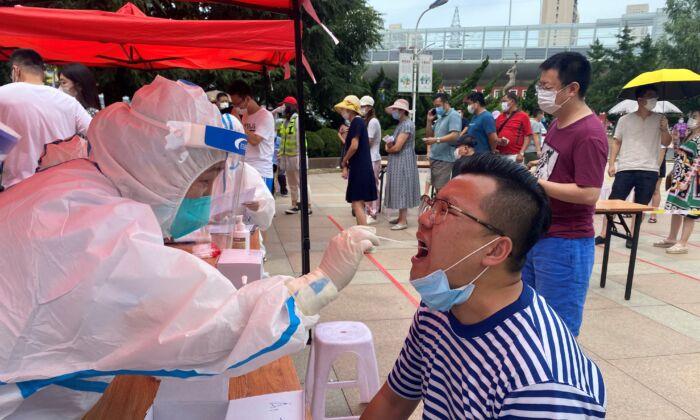The Epoch Times recently obtained a trove of documents, including an internal notice about a confidential teleconference on Jan. 14 with provincial and municipal health officials.
This confidential notice asked all relevant officials to attend an online training at 10 a.m. on Jan. 15.
The training session focused on how to proceed with the diagnosis and treatment of CCP virus infection, containment policy, and deployment of medical assistance in hospitals according to instructions of the NHC.
Another document is titled, “Teleconference talk on new coronavirus by director Jiao.” Jiao refers to Jiao Yahui from the commission’s Medical Administration and Supervision Department.
The document was a transcript of a presentation given by Jiao Yahui on Jan. 15 regarding the CCP virus.
Five Secrets Revealed in the Transcript
During the teleconference’s training session, Jiao Yahui’s presentation disclosed five major key points that have been hidden by the regime.1. The CCP was aware of the outbreak
At the beginning of the talk, Jiao asked “everyone to maintain a high degree of vigilance,” because “everyone’s perception of this work is indeed different (from what’s demanded), and there is a big gap.”When Jiao reminded officials of all localities to “keep a high degree of vigilance,” it was during the peak season of travel during the Chinese New Year. At that time, the CCP vehemently denied human-to-human transmission of the virus, and eight doctors were punished for “rumor-mongering.” The truth of the epidemic was kept not only from the general public, but also from medical staff at the grassroots level.
2. The regime prioritizes discipline and stability over public health
Before discussing the specific work, Jiao repeatedly emphasized discipline, “that is, we want to make the inside tight and the outside loose.”Jiao said, “Don’t create panic and instability in society“ because Chinese New Year is coming. She specifically emphasized, ”Everyone should not disclose in the circle of friends and the internet, but only for internal use at work.”
Jiao’s statement confirmed what’s believed to be the regime’s decision to conceal the truth to preserve the festive holiday atmosphere and social stability at the cost of missing the golden time to prevent the spread of the outbreak.
3. Infection prevention comes second
Jiao spoke about the formation of a team of experts specializing in “respiratory, infectious, acute care, imaging, and examination,” and “preparations” of supplies including protective gear, disinfectants, and antivirus products and medicines.4. The “rule” to confirm a case
It is worth mentioning what Jiao specifically emphasized: “to strictly implement the diagnosis (procedure) of the first case.”It is required that diagnosis and publishing the first confirmed case cannot be done by local authorities. It must be “confirmed by state and published by province.” That is, the testing and confirmation will be done by China’s National Disease Control Center (CDC).
Jiao also emphasized that even after the first confirmed case is made, subsequent cases still need to be “reviewed and approved by the national CDC laboratory,” and the diagnosis and public announcement are organized by the province.
5. Avoid “social panic” caused by deaths
Jiao said, “Especially if there are many death cases, it will easily cause panic in society, panic about disease and an epidemic situation.” Jiao said about reducing the mortality rate, “this is the focus of our critical care.”Chengdu Epidemiologic Investigation Report Confirms Part of Jiao’s Talk
A Jan. 16 report from the CDC of Chengdu city, Sichuan Province, proved that the “rule” of prohibiting local authorities from confirming cases was strictly followed.According to this report, a patient surnamed Yang developed a fever on Jan. 3 in Wuhan. He returned to Chengdu on Jan. 9 after receiving treatment. Afterward, he repeatedly developed a fever and sought medical treatment. He was admitted to Chengdu First People’s Hospital on Jan. 11 and was treated in isolation.
The report said that on Jan. 15, the hospital took a sample from Yang onsite and sent it to the CDCs of both Chengdu and Sichuan for testing. On Jan. 16, the provincial CDC reported that his sample tested positive in a nucleic acid test.
Based on this, the Chengdu CDC made a “preliminary investigation conclusion” in the report: “This case is an observation case and diagnosed as a new coronavirus-infected pneumonia case. Further confirmation is required to combine with the national CDC diagnosis.” In other words, the case was not confirmed at that time.
In fact, according to China’s Jan. 21 epidemic briefing, as of Jan. 20, only Hubei Province, Guangdong Province, Beijing, and Shanghai had “confirmed” cases. This shows that the national CDC failed to confirm Yang’s test on Jan. 16.
The Epoch Times Reports Numerous Coverups by the CCP
The Epoch Times has repeatedly exposed internal documents that revealed the CCP’s coverup of the epidemic.It asked hospitals to take measures to prevent the disease from spreading inside their facilities and train staff on such actions. It also asked hospitals to set up fever clinics and to “pre-screen and triage” anyone experiencing a fever, to determine levels of urgency for treating patients.
The notice was marked “for internal use only, and cannot be distributed on the internet.”
Commentator Li Linyi said this document shows that the CCP long knew that the virus was highly contagious and may spread rapidly, but insisted on concealing that information from the public.




